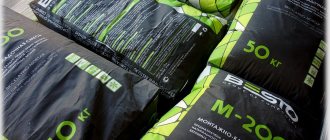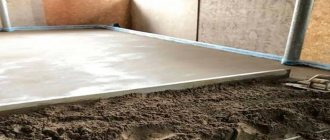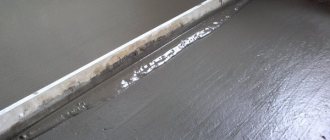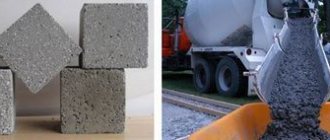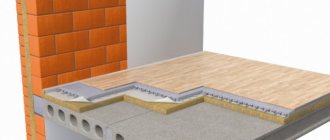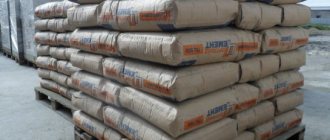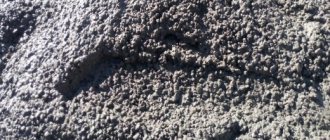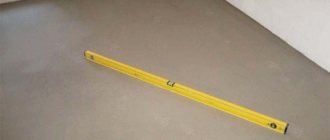Floor screed mortar, at first glance, is very easy. However, in fact, it is the proportions that are of paramount importance in the work. If materials are mixed incorrectly, further work can turn into a waste of effort, time and money. Therefore, in construction, floor screed is considered the most critical stage, and its quality affects the quality of future floors.
Proportions of components for floor screed: 1:3 – (1 part M400 cement to 3 parts sand) I.e. for 10 kg of cement add 30 kg of sand.
The importance of proportions
Currently, the range of floor coverings is teeming with variety: putty, tiles, plaster, etc. However, it is impossible to know about their strength and the volume of added cement by purchasing them ready-made. In addition, there are various chemical additives that increase the strength of materials. And in this again the main role is given to cement. You should know that during the manufacturing process the same amount of cement is added at the factory; they do not skimp on this, and the indicated strength, as a rule, corresponds to the actual one.
The range of dry building mixtures for screed is huge and is in demand on the market.
Screed strength
Basically, the compressive strength is indicated on the packaging of many formulations, and it is 10 MPa. Regarding concrete, the brand of mortar M150, which has an MPA of 12.8, is closest to this indicator.
It should be remembered that when drawing up proportions, people take ideal conditions, i.e. sand containing a minimal amount of clay. This must be remembered, because during manufacture, clay can envelop a grain of sand, thereby reducing its adhesion, resulting in reduced strength. Therefore, it is very difficult to give specific figures. In such cases, the proportion of cement in the concrete solution increases by 20 percent and the amount of liquid decreases.
It should be noted that the durability of concrete pavements, as well as its quality, depends not so much on the materials used, but on the correctness of all proportions. Thus, problems with sound, heat and moisture insulation, communication systems, etc. can be solved.
A mixture of cement and sand.
CPS are mixtures of cement and sand, often used for floor screed. They are easy to prepare yourself, but for this you also need to know all the proportions of cement and sand for preparing the floor screed. It is worth noting that in such proportions the figures depend mainly on the planned loads on the floor; the higher it is, the more cement is added to the concrete solution (this especially applies to large stores and industrial premises).
Proportions are also influenced by factors such as surface leveling, planning for raising the floor surface, the need to camouflage various pipes and communication systems, and the distribution of load on layers of sound and thermal insulation.
Proportions of cement to sand for screed
First of all, the proportions of the mortar for floor screed depend on the brand of cement.
| brand of cement | design grade of concrete | mass composition: cement: sand: crushed stone | average volume cement:sand:gravel | resulting volume of concrete (10 l cement) |
| 400 | 100 | 1:4,6:7 | 10:41:61 | 78 |
| 500 | 100 | 1:5,8:8,1 | 10:53:71 | 90 |
| 400 | 150 | 1:3,5:5,7 | 10:32:50 | 64 |
| 500 | 150 | 1:4,5:6,6 | 10:40:58 | 73 |
| 400 | 200 | 1:2,8:4,8 | 10:25:42 | 54 |
| 500 | 200 | 1:3,5:5,6 | 10:32:49 | 62 |
| 400 | 250 | 1:2,1:3,9 | 10:19:34 | 43 |
| 500 | 250 | 1:2,6:4,5 | 10:24:39 | 50 |
| 400 | 300 | 1:1,9:3,7 | 10:17:32 | 41 |
| 500 | 300 | 1:2,4:4,3 | 10:22:37 | 47 |
| 400 | 400 | 1:1,2:2,7 | 10:11:24 | 31 |
| 500 | 400 | 1:1,6:3,2 | 10:14:28 | 36 |
It is necessary to pay attention that for floor screed the grade of mortar must be at least M150; M200 is often used.
Brand of cement-sand mortar for screed: choice of strength
What brand of cement-sand mortar is used for screed? Previously, they could put M50 or M75. Now the minimum is M150. Why? Because, first of all, the finishing requirements were much lower. What was previously considered normal - small holes, cavities, cracks - is now unacceptable. And this is not just “aesthetics”. To a greater extent, these are the requirements of finishing coating manufacturers. They require an almost ideal surface that does not generate dust, and only a solution with a strength of at least M100 can provide this.
The brand of cement-sand mortar for screed is selected based on the floor covering being laid
There are other reasons why a higher brand of solution is used. First. No one is sure of the quality of cement, so they prefer to play it safe than to redo it all over again. Secondly, modern coatings require a flat, solid base and the screed mortar must be durable. And thirdly, you simply cannot install a low grade under self-leveling compounds or modern tile adhesives with polymer additives. To prevent the two parts of the coating from delaminating, the difference in strength should be no more than 50 units. That is, if the leveling mixture has a strength of M250, the floor screed solution must have a strength of M200 and not lower. Same thing with tile adhesive. So pay attention to this.
Calculation of floor screed
Quite often, before carrying out repairs, it is necessary to calculate the amount of material required, this also applies to floor screed.
You can calculate the solution for floor screed as follows.
First of all, the required volume of building materials is calculated. To do this, the thickness of the future screed is multiplied by the coverage area.
For example, with a floor area of 40 sq.m. and a layer 5 centimeters thick. In such cases, 40 * 0.05 = 2 cubic meters of solution are needed.
After this, the amount of cement and sand is calculated. Mixing the solution occurs in a ratio of 1 to 3, therefore, 0.5 cubic meters of cement and 1.5 cubic meters of sand are required. The weight of a cubic meter of cement is approximately 1300 kilograms, which means that to screed a room with an area of 40 sq.m. you will have to purchase about 650 kilograms of cement (0.5 * 1.3). Thus, you can calculate the proportion and consumption of materials for screeding a floor of a specific area. Thanks to this calculation, you can purchase the required amount of building materials in advance.
Maintaining optimal proportions is the key to high-quality work and as a result of a long service life of the screed.
You should know that when preparing a concrete solution, the mixture has an unpleasant feature - its volume gradually increases. There is a simple explanation for this: the filler, which contains small particles, penetrates into the voids of the concrete solution, filling them and thereby reducing the volume. Therefore, when using 1 cubic meter of dry mixture, under good conditions, it produces no more than 0.7 cubic meter of the finished solution. Therefore, to prepare 1 cubic meter of solution, you need to take a little more dry substances with a reserve.
Additives: necessary or not?
It may be recommended to add plasticizers and fiberglass or other substances for micro-reinforcement to a classic floor screed solution. Are they needed or not? First you need to understand what it is and why.
When making a screed mortar, you can get by with only sand and cement
Plasticizing additives
Plasticizers are substances that increase the plasticity of DSP. It is easier to work with such solutions. Concrete with a plasticizer adheres better, is easier to level, and gives a smoother surface. In general, if all the components are of normal quality and well mixed, then it is not difficult to work with them when mixed with water. With additives, of course, it’s easier. But factory plasticizers cost a lot of money, and this increases the cost of the screed. They need to be added in small quantities, but when pouring the floor in a house, the cost is per cubic meter, so the costs will be noticeable.
When mixing, the proportions of the solution must be observed with great precision. To make the solution fit better, add plasticizers rather than more water
As usual, craftsmen have found a replacement for factory plasticizers. Add regular soap to the solution. Its consumption is very small - a glass or so for one concrete mixer. The plasticity of the solution increases, so many people use this type of additive. For beginners, it is worth saying: do not exceed the recommended dose. The solution will not get better, but it may well get worse. Soap increases plasticity by “lubricating” the sand, reducing its “adhesion” to the cement slurry. Exceeding the dosage may lead to a decrease in the strength of the screed. So be specific.
Micro-reinforcement
As you know, when drying, cement-sand mortar shrinks. The amount of shrinkage is from 1.5% to 3% of the volume. The exact percentage of shrinkage depends on the amount of foreign impurities (if the sand is washed, the shrinkage will be less), the correctly selected composition of the filler (in this case, sand), precisely observed proportions and a number of other conditions and factors.
This is what polypropylene fiber fiber looks like
Everything would be fine, but when shrinkage occurs, cracks form in the solution. They are always there, only larger or smaller in size, in larger or smaller quantities. To reduce the number of cracks, micro-reinforcement materials are added to the solution. Fiber fiber is most often used in everyday life. It happens:
- fiberglass;
- basalt;
- metal;
- polypropylene.
The most popular fiber for household purposes is polypropylene fiber. It is the most inexpensive and gives good results. How does it work? 100 grams of this supplement contains a huge amount of synthetic fibers. They are very thin, but synthetics are highly durable. These fibers are randomly but evenly distributed throughout the entire thickness of the solution. In concrete, they form a kind of lattice in space. When stresses arise when the screed dries, they bind the parts of the mortar together, reducing the number and size of cracks.
It is important to comply with supplement standards
The second effect of fiberglass is a smoother and more durable surface. So this additive to the floor screed solution is more useful and is definitely worth using. But again, strictly according to the recommendations. It seems that if you add more fiber, there will be fewer cracks, but no. The strength of the screed will decrease.
Mixing solution components
The dry and liquid components of the solution are mixed in various containers. The mortar for filling the floor is made according to the proportions in a certain order. First of all, the dry components are mixed, that is, fiber, sand and cement. M400 cement is mixed with sand in a ratio of 1 to 3, for example, 50 kilograms of sand requires 16.7 kg of cement. Mixing of dry elements is carried out for 5 minutes.
In the second container, the plasticizer is mixed with water. For 50 kg of cement, about 190 g of plasticizer is required. The required volume of water is 1/3 of the mass of cement, that is, 5.6 liters of water are needed for 1/3 of the bag (taking into account that 0.6 liters will be used for the plasticizer). Then the liquid and dry elements are mixed, and then the dry mixture is gradually poured into a container with water, while it is mixed well.
To mix the mixture without lumps, it is best to use a construction mixer.
When pouring water into a dry mixture, lumps may appear that are difficult to stir.
Mixing the solution by hand is very long and difficult, so it is recommended to use a construction mixer or a drill with an attachment. Power tools allow you to perform this procedure more efficiently.
So, the floor screed is ready, and with the correct proportion of cement and sand, you can get a reliable solution. It should be borne in mind that working with a viscous solution is much more difficult, but there will be fewer cracks on the surface.
To avoid the formation of cracks when drying, it is necessary to wet the surface daily.
General information about the composition of the screed solution
The process of preparing mortar for floor screed
The process of preparing a solution for floor screed comes down to thoroughly mixing certain components in prescribed proportions. The most versatile and frequently used are cement-based mixtures: they are not afraid of moisture, which allows you to pour such solutions in any room.
Cement mortar
The main disadvantage of cement mortars is their tendency to shrink, which has fairly high rates. Therefore, if the solution is poorly mixed and laid in a thin layer, the surface is likely to become covered with cracks. In order to prevent cracking, the screed is made using reinforcing mesh. In addition, special strengthening components can be included in the solution.
The composition of the cement floor screed is given in the following table.
Table. Composition of mortar for floor screed
| Component | Functions |
| Cement | It is the basis of the composition for floor screed. Responsible for the strength and other significant performance characteristics of the fill. |
| Sand | As a rule, thoroughly washed construction sand is used. Performs the functions of fine aggregate. It is strictly not recommended to use river sand - the screed will be of extremely low quality. |
| Polypropylene fiber fiber | The use of this component allows you to maximize the quality of the screed. The material helps to reduce the severity of the main disadvantage of cement compositions - plastic shrinkage. In addition, the fiber helps to increase the strength and service life of the screed. Professional builders strongly recommend using polypropylene fiber to prepare screeds. Although this will lead to a slight increase in the cost of work, the surface will not become covered with cracks with almost 100% probability. |
| Plasticizer | Helps to increase the plasticity of the finished mixture, which makes it possible to lay the screed with less water and increases the available period of use of the mixture to an average of 8-12 hours. |
| Water |
When choosing the proportions of the screed solution, it is necessary to take into account the operating characteristics of the room in which the finishing work will be carried out. For example, if the floor will be subjected to intense loads and strong mechanical stress, it is recommended to use 1 share of cement and 3 shares of sand to prepare the solution. With this ratio, the screed will be strong and quite reliable.
The proportions of the solution depend on the purpose of the room
In general, the composition of the mixture can be adjusted by decreasing or increasing the proportion of one or another component. But it is important to know that as the sand content decreases, the strength of the screed will also decrease - such a coating will quickly become covered with cracks, lose its performance characteristics and collapse.
The screed may crack if there is too little or too much sand in the mixture.
For residential premises with low and medium loads, solutions consisting of 1 part of cement and 4 parts of sand are usually used. The amount of other components is selected practically until a mixture of normal working density is obtained or in accordance with the manufacturers' recommendations. This composition allows you to obtain a fairly high-quality solution for laying screed. At the same time, it is also impossible to add too much sand to the mixture, because... Because of this, the strength properties of the coating will be compromised and the filling will collapse quite quickly.
As for the reinforcing fiber, it is added in an amount of about 0.6-0.9 kg per 1 m3 of the finished solution. The required proportion of plasticizer should be clarified individually - manufacturers provide this information in the instructions for their products. Water, if you adhere to the given proportions of other components, will need to be added in an amount of about 15 liters for every 50 kg of cement.
Plasticizer for concrete
FIBAR-fiber fiber made of polypropylene
Plasticizer for concrete Plitonit
In addition to cement screeds, special gypsum mortars are often used. As a rule, they are used to eliminate small irregularities in conditions where there is no time to wait for the cement screed to completely harden. Anhydride mixtures can be laid in a thin layer, and they dry on average in 1-3 days, which significantly facilitates and speeds up the work process. The only limitation: gypsum screeds are not suitable for use in rooms with high air humidity.
If desired, both cement and gypsum compositions can be purchased ready-made, with all the necessary plasticizers and other additives. Manufacturers often introduce special modifiers into their mixtures that improve various properties of the screed, for example, increasing its fluidity and facilitating the installation process. However, under any circumstances, you will have to spend more money to purchase a ready-made mixture than to purchase the initial components separately and prepare the solution yourself.
Additives to concrete
The choice of proportions depending on the brand of raw materials and the finished composition
When determining the optimal composition of the mortar for the screed, you must, first of all, focus on the indicator of the grade of cement, as well as the required grade of the finished mortar - the higher the latter indicator, the stronger and more durable the screed will be. Information regarding these points is given in the following table.
Table. Proportions of mortar for screed
| Brand of cement used | Contents of main ingredients | |
| 600 | 1 share of cement, 3 shares of sand | 300 |
| 600 | 1 share of cement, 4 shares of sand | 200 |
| 500 | 1 share of cement, 2 shares of sand | 300 |
| 500 | 1 share of cement, 3 shares of sand | 200 |
| 400 | equal shares of cement and sand | 300 |
| 400 | 1 share of cement, 3 shares of sand | 150 |
| 300 | equal shares of sand and cement | 200 |
| 300 | 1 share of cement, 3 shares of sand | 100 |
Important! To fill the screed, it is strongly recommended not to use a solution of a grade lower than M150 - it may not hold up. In most cases, in home construction, a mixture of the M200 brand is used.
Types of filler and their purpose
There is a coarse aggregate used mainly in the process of producing heavy concrete (crushed stone, gravel, etc.). There is also fine aggregate, which is used only when preparing ordinary concrete. Surely, everyone knows that sand is used almost everywhere in construction, and the process of preparing concrete mortar is no exception. Sand is called fine aggregate because its grains are quite small in size. But sand can also be coarse, medium and fine.
Sand for mortar is a necessary component and it varies in size. Photo to compare the size of sand grains.
Floor screed: which is better - concrete or cps?
Before starting to screed a floor, many people are faced with the question of what is better: concrete or cement-sand mixtures? Practice shows that for thin screeds it is desirable to use a mixture of cement and sand, and for thick screeds (more than 4 cm thick) it is recommended to use traditional concrete, because it does not crack.
There is one more thing you need to know. When concrete is mixed with expanded clay, an excellent heat insulator is obtained, and when mixed with crushed stone, the resulting coating can withstand enormous loads (crushed stone has excellent adhesion to cement).
In addition, concrete is selected when pouring the bud mixture onto the ground to obtain a monolithic base or decorative coating.
It is worth adding that if you have a minimum set of tools (measuring container, shovel, scoop, bucket) and a calculator, you can independently calculate the correct proportions. And with a known proportion of concrete or cement, or other components, you can independently make a high-quality mixture for floor screed. In addition, if you wish, you can find many graphs, tables, electronic calculators and other useful materials about portioning on the World Wide Web.
Screed application technology
Next, we will briefly consider the technology for constructing a concrete screed without the involvement of professional builders. For these purposes, you can use a solution prepared either from a ready-made dry mixture or with your own hands using cement and sand.
Preparing the load-bearing surface
Pre-applied primer will improve the adhesion of the base to concrete
Before you begin constructing the screed, you should prepare the load-bearing surface:
- Prime. This will create additional protection for subfloors and increase their adhesion to the materials applied above.
- Construct waterproofing. For wooden floors, it is recommended to use rolled moisture-repellent material, laid with overlapping joints. For concrete bases, you can use liquid mastics on a bitumen or polymer base, applied with a brush or roller.
- Insulation. If necessary, a layer of thermal insulation can be installed between the waterproofing layer and the screed itself. For these purposes, it is best to use a material with a density of over 30 kg/1 cubic meter, for example, extruded polystyrene foam.
Reinforcement and filling of screed
The next step is to reinforce the surface to avoid cracking of the screed. Reinforcing mesh made of fiberglass or metal wire can be purchased at a construction supermarket or knitted yourself from thin reinforcement.
Next, using a hydraulic level or a laser level, we set the beacons. To do this, we use metal or wooden slats, laid on the surface of the base in increments of about 1 m. For more information about the use of composite reinforcement, see this video:
If the room has an underground floor, then its hatch should be fenced with formwork.
A damper tape should be installed along the perimeter of the walls at the pouring level to compensate for expansion-compression cycles of the screed as the temperature inside the room changes. After this, you can begin pouring the solution into the compartments formed by the beacon slats. To level the mixture, you can use a long rule.
